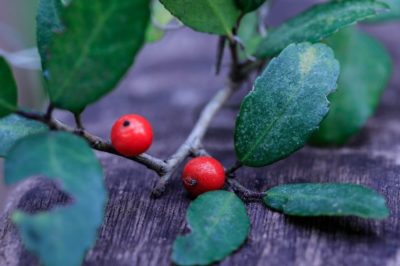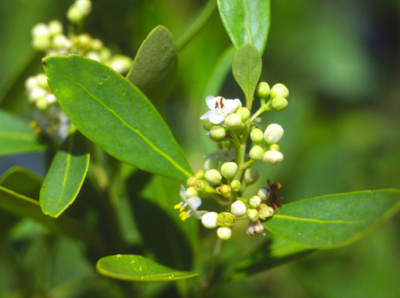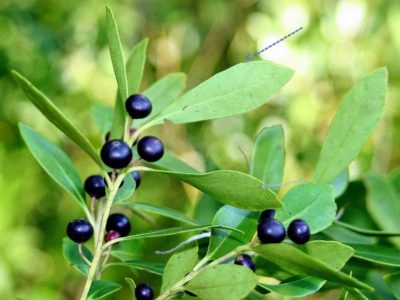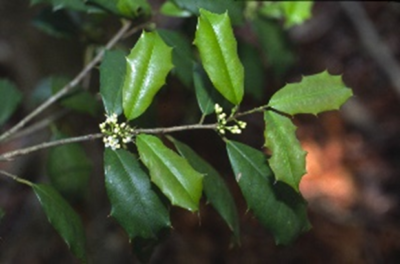
Female Yaupon (Ilex vomitoria) with berries. Photo by Sandra Robinson.
This week, we continue our investigation of plants that have become culturally important during the winter holiday season. Previously, we looked at mistletoe and its significance both to humans and to the natural environment in which it is found. In this post, we will look at holly (Ilex spp.) and its cultural and ecological significance.
In the winter traditions that have their origins in Stone Age Europe, North Africa and the Middle East, holly was one of several plants revered for its evergreen nature. The others include mistletoe, pine, yew, fir, ivy, cedar and laurel. Of these, only holly plants bear bright red berries through the dark winter months, giving us the colors green and red that have been associated with winter festivals from the ancient Roman Saturnalia to Christmas in the present day.
The holly genus Ilex currently contains more than 664 extant species with a near cosmopolitan distribution in temperate and tropical regions around the world. Plants in this genus commonly have simple, alternate leaves, which may be evergreen or deciduous, depending on the species. Slower growing evergreen types often have a spiny leaf margin to deter herbivory. The inconspicuous flowers are green or white, each with four petals. Hollies are generally dioecious, with male and female flowers borne on separate plants; therefore only female plants will produce the iconic red or black berries typical of the genus, and only if there’s a male plant nearby. Wherever holly is found, the flowers are an important nectar source for invertebrate pollinators like bees, and the berries (technically drupes) that follow are an important winter food source for wildlife, especially for songbirds.


Flowers of a male Inkberry (Ilex glabra) (left) & berries on a female plant of the same species (right). Photos by Bruce K. Holst.

American holly (Ilex opaca) in bloom. Photo by Bruce K. Holst.
Most Ilex species are found in the tropics and subtropics, especially in the Americas and Asia, with a smaller distribution in temperate regions. Today, the highest diversity of hollies are found in SW China and in the Andes (Yao et al. 2020). Europe has only one species, the familiar common holly (Ilex aquifolium) of winter festivals and folklore. There are 17 species of holly native to eastern North America, 11 of which occur in Florida. The most widespread in the state are Dahoon (Ilex cassine), American holly (Ilex opaca), Inkberry (Ilex glabra) and Yaupon (Ilex vomitoria). Of these, American holly most resembles the holly of Eurasian winter holidays. The rarest is Krug’s holly (Ilex krugiana), a Caribbean species found on the US mainland only in Miami-Dade County.
Hollies are very ornamental and today they are widely popular both as landscape plants and holiday decorations. Despite the berries and leaves being consumed by wildlife, most holly species are moderately toxic to humans due to the presence of saponins, and eating large quantities of the attractive berries can cause vomiting and severe diarrhea. Poisonings most often occur in children, but fatalities are extremely rare, regardless of common belief (Evens & Stellpflug 2012). Despite the toxicity, some holly species have been used medicinally by a number of cultures. For example, in Chinese traditional medicine, the leaves of Ilex cornuta are used to treat a number of disorders, including headache, weakness of knees, conjunctivitis, toothache, rheumatism and cardiovascular disease; and the anti-inflammatory properties of this traditionally-used species has recently been confirmed by science (Kim et al. 2017). In other cultures, holly leaves are used to brew teas and tisanes, the most popularly known is Yerba Mate, a caffeine-rich herbal tea brewed from the leaves and twigs of the South American Ilex paraguayensis. Even the leaves of our native Yaupon (I. vomitoria) and Dahoon (I. cassine) are rich in caffeine and similar compounds, and they were brewed into a tea by the native American peoples of the southeast and Florida.
Check out this fantastic Florida Native Plant Society blog post from 2010 regarding our native hollies and their place in our winter traditions. And if you reside in Sarasota or Manatee Counties, please consider joining the Ecoflora project, which challenges residents to become engaged in citizen science using the iNaturalist app to collect vital information and photographs of our native flora and fauna. Through a series of EcoQuests, citizens can help researchers collect important information about species of conservation interest. This month’s EcoQuest is titled “Home for the Hollydays” and the challenge is to locate and identify the native holly species wherever they are found.
Written by Shawn McCourt, Ph.D., Selby Gardens’ plant records keeper
